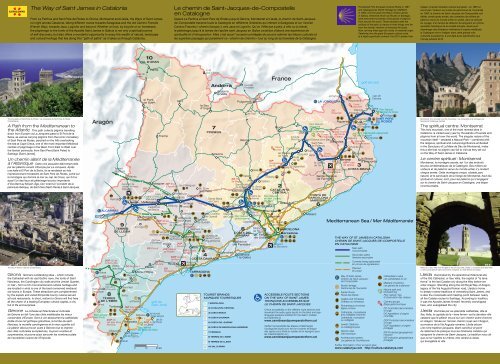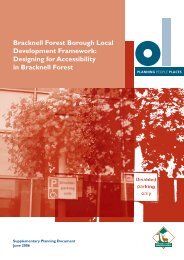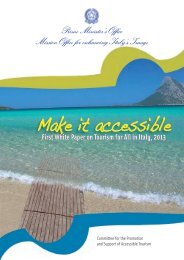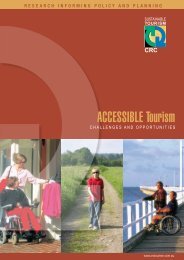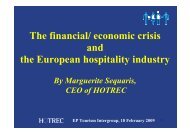France Aragón Le chemin de Saint-Jacques-de-Compostelle en ...
France Aragón Le chemin de Saint-Jacques-de-Compostelle en ...
France Aragón Le chemin de Saint-Jacques-de-Compostelle en ...
Create successful ePaper yourself
Turn your PDF publications into a flip-book with our unique Google optimized e-Paper software.
The Way of <strong>Saint</strong> James in Catalonia<br />
From <strong>Le</strong> Perthus and Sant Pere <strong>de</strong> Ro<strong>de</strong>s to Girona, Montserrat and Lleida, the Ways of <strong>Saint</strong> James<br />
run right across Catalonia, taking differ<strong>en</strong>t routes towards Saragossa and the old Camino Francés<br />
(Fr<strong>en</strong>ch Way), towards Jaca, Logroño and beyond. Whether on foot, by bicycle or on horseback,<br />
the pilgrimage to the tomb of the Apostle <strong>Saint</strong> James in Galicia is not only a spiritual journey<br />
of self-discovery, but also offers a won<strong>de</strong>rful opportunity to <strong>en</strong>joy the wealth of natural, landscape<br />
and cultural heritage that lies along this “path of paths” as it takes us through Catalonia.<br />
8<br />
TERRES<br />
DE L’EBRE<br />
9<br />
TERRES<br />
DE LLEIDA<br />
10<br />
VAL D’ARAN<br />
túnel <strong>de</strong><br />
Vielha<br />
Vielha<br />
<strong>Le</strong> <strong>chemin</strong> <strong>de</strong> <strong>Saint</strong>-<strong>Jacques</strong>-<strong>de</strong>-<strong>Compostelle</strong><br />
<strong>en</strong> Catalogne<br />
Depuis <strong>Le</strong> Perthus et Sant Pere <strong>de</strong> Ro<strong>de</strong>s jusqu’à Gérone, Montserrat et Lleida, le <strong>chemin</strong> <strong>de</strong> <strong>Saint</strong>-<strong>Jacques</strong><strong>de</strong>-<strong>Compostelle</strong><br />
traverse toute la Catalogne <strong>en</strong> différ<strong>en</strong>ts itinéraires qui mèn<strong>en</strong>t à Saragosse et sur l’anci<strong>en</strong><br />
Camino Francés (« <strong>chemin</strong> français ») vers Jaca et Logroño. Qu’on l’effectue à pied, à vélo ou à cheval,<br />
le pèlerinage jusqu’à la tombe <strong>de</strong> l’apôtre saint <strong>Jacques</strong> <strong>en</strong> Galice constitue d’abord une expéri<strong>en</strong>ce <strong>de</strong><br />
spiritualité et d’introspection. Mais c’est aussi l’occasion privilégiée <strong>de</strong> pouvoir admirer les trésors culturels et<br />
les superbes paysages qui parsèm<strong>en</strong>t ce « <strong>chemin</strong> <strong>de</strong> <strong>chemin</strong>s » tout au long <strong>de</strong> sa traversée <strong>de</strong> la Catalogne.<br />
4<br />
3143<br />
pica d’Estats<br />
Andorra<br />
7<br />
PIRINEUS<br />
COSTA DAURADA<br />
Andorra<br />
la Vella<br />
5<br />
túnel <strong>de</strong><br />
Pimor<strong>en</strong>t<br />
COSTA DEL<br />
GARRAF<br />
<strong>France</strong><br />
2<br />
CATALUNYA<br />
CENTRAL<br />
1 Barcelona<br />
BARCELONA<br />
COSTA DE<br />
BARCELONA<br />
MARESME<br />
6<br />
Proclaimed First European Cultural Route in 1987<br />
and catalogued as World Heritage by UNESCO<br />
in 1993, over the years the Ways of <strong>Saint</strong> James<br />
in Galicia, otherwise known as Routes of Santiago,<br />
have welcomed hundreds of thousands of pilgrims<br />
from around the world. These travellers seek the<br />
solitu<strong>de</strong> of the path, a chance to think things over far<br />
from the fr<strong>en</strong>etic rhythms of everyday life today.<br />
Now, reviving these age-old routes of medieval origin,<br />
Catalonia joins the great European cultural route<br />
at a highly significant mom<strong>en</strong>t: the 2010 Jubilee Year.<br />
3<br />
golf <strong>de</strong> Lleó<br />
COSTA BRAVA<br />
Classé « premier itinéraire culturel europé<strong>en</strong> » <strong>en</strong> 1987 et<br />
inscrit par l’Unesco sur la liste du patrimoine <strong>de</strong> l’humanité<br />
<strong>en</strong> 1993, le <strong>chemin</strong> <strong>de</strong> <strong>Saint</strong>-<strong>Jacques</strong>-<strong>de</strong>-<strong>Compostelle</strong> voit<br />
défiler, année après année, <strong>de</strong>s c<strong>en</strong>taines <strong>de</strong> milliers <strong>de</strong><br />
pèlerins v<strong>en</strong>us du mon<strong>de</strong> <strong>en</strong>tier <strong>en</strong> quête, dans la solitu<strong>de</strong><br />
du voyage, d’un temps <strong>de</strong> réflexion les éloignant du rythme<br />
quotidi<strong>en</strong> frénétique <strong>de</strong> la société actuelle. Après avoir<br />
réaménagé <strong>de</strong>s itinéraires millénaires d’origine médiévale,<br />
la Catalogne vi<strong>en</strong>t s’intégrer dans cette gran<strong>de</strong> voie<br />
culturelle europé<strong>en</strong>ne, à une date aussi significative que<br />
l’année jubilaire 2010.<br />
el Pont<br />
<strong>de</strong> Suert<br />
Sort<br />
la Seu<br />
d’Urgell<br />
Puigcerdà<br />
túnel<br />
<strong>de</strong>l Cadí<br />
el Pertús<br />
LA JONQUERA<br />
DO<br />
Empordà<br />
Reques<strong>en</strong>s<br />
Cuina<br />
<strong>de</strong>l V<strong>en</strong>t<br />
Vilajuïga<br />
Peralada<br />
cap <strong>de</strong><br />
Cervera<br />
El Port<br />
<strong>de</strong> la Selva Parc Natural<br />
<strong>de</strong>l Cap <strong>de</strong> Creus<br />
Portlligat<br />
The monastery of Sant Pere <strong>de</strong> Ro<strong>de</strong>s / <strong>Le</strong> monastère <strong>de</strong> Sant Pere <strong>de</strong> Ro<strong>de</strong>s<br />
(Costa Brava)<br />
A Path from the Mediterranean to<br />
the Atlantic This path collects pilgrims travelling<br />
down from Europe via La Jonquera pass to El Port <strong>de</strong> la<br />
Selva, as well as carrying pilgrims from the iconic monastery<br />
of Sant Pere <strong>de</strong> Ro<strong>de</strong>s, perched on the hills overlooking<br />
the sea at Cape Creus, one of the most important Medieval<br />
c<strong>en</strong>tres of pilgrimage in the West. From East to West over<br />
the Iberian p<strong>en</strong>insula: from Sant Pere [<strong>Saint</strong> Peter] to<br />
Santiago [<strong>Saint</strong> James].<br />
Un <strong>chemin</strong> allant <strong>de</strong> la Méditerranée<br />
à l’Atlantique Cette voie jacquaire était empruntée<br />
par les pèlerins v<strong>en</strong>ant d’Europe par La Jonquera. Après<br />
une halte à El Port <strong>de</strong> la Selva, ils se r<strong>en</strong>dai<strong>en</strong>t au très<br />
impressionnant monastère <strong>de</strong> Sant Pere <strong>de</strong> Ro<strong>de</strong>s, juché sur<br />
la montagne qui domine la mer au cap <strong>de</strong> Creus, qui fut lui<br />
aussi l’un <strong>de</strong>s lieux <strong>de</strong> pèlerinage les plus importants<br />
d’Occi<strong>de</strong>nt au Moy<strong>en</strong>-Âge. De l’ori<strong>en</strong>t à l’occi<strong>de</strong>nt <strong>de</strong> la<br />
péninsule Ibérique, <strong>de</strong> Sant Pere (<strong>Saint</strong> Pierre) à <strong>Saint</strong>-<strong>Jacques</strong>.<br />
The city of Girona / Gérone (Costa Brava)<br />
Girona Girona’s outstanding sites – which inclu<strong>de</strong><br />
the Cathedral with its vast Gothic nave, the tomb of <strong>Saint</strong><br />
Narcissus, the Carolingian city walls and the Jewish Quarter,<br />
or Call – form a rich monum<strong>en</strong>tal and cultural heritage and<br />
are located in what is one of the best-conserved medieval<br />
old towns in Europe. These attractions are complem<strong>en</strong>ted<br />
by the superb and varied Empordà county cuisine served<br />
at local restaurants. In short, visitors to Girona will find here<br />
all the charm of a leading European cultural capital, a city<br />
full of life and surprises.<br />
Gérone La richesse architecturale et culturelle<br />
<strong>de</strong> Gérone <strong>en</strong> fait l’une <strong>de</strong>s cités médiévales les mieux<br />
conservées d’Europe. Sont à voir absolum<strong>en</strong>t la cathédrale,<br />
dotée d’une nef gothique grandiose, la tombe <strong>de</strong> saint<br />
Narcisse, la muraille carolingi<strong>en</strong>ne et le vieux quartier juif.<br />
<strong>Le</strong> pèlerin découvrira <strong>en</strong> outre à Gérone tout le charme<br />
<strong>de</strong>s villes culturelles europé<strong>en</strong>nes, toujours vivantes et<br />
surpr<strong>en</strong>antes, et pourra aussi savourer les nombreux plats<br />
<strong>de</strong> l’excell<strong>en</strong>te cuisine <strong>de</strong> l’Empordà.<br />
Vilabertran SANT PERE<br />
<strong>Aragón</strong><br />
Figueres<br />
DE RODES<br />
Parc Natural<br />
Castelló Roses<br />
Ripoll<br />
<strong>de</strong> la zona<br />
d’Empúries<br />
volcànica<br />
Grup<br />
<strong>de</strong> la Garrotxa<br />
Olot<br />
Gastronòmic<br />
Parc Natural <strong>de</strong>ls Aiguamolls<br />
Cuina <strong>de</strong>l Pla <strong>de</strong><br />
Tremp<br />
<strong>de</strong> l’Empordà<br />
túnel <strong>de</strong><br />
Volcànica l’Estany<br />
Empúries<br />
Berga<br />
Bracons<br />
Bàscara<br />
Sant Esteve d’<strong>en</strong> Bas<br />
Sant Feliu<br />
Banyoles Cuina <strong>de</strong><br />
l’Empordanet<br />
<strong>de</strong> Pallerols<br />
Osona<br />
Cervià <strong>de</strong> Ter<br />
cuina<br />
Cantonigròs<br />
Rupit<br />
Solsona<br />
les Masies<br />
l’Esquirol<br />
Girona<br />
Púbol<br />
<strong>de</strong> Roda<br />
Amer Bons Fogons<br />
Roda<br />
<strong>de</strong> Ter<br />
Girona la Bisbal<br />
IGP<br />
la Cellera<br />
Salt<br />
d’Empordà<br />
Llonganissa<br />
IGP Poma<br />
<strong>de</strong> Vic<br />
<strong>de</strong> Ter<br />
<strong>de</strong> Girona<br />
Vic Folgueroles<br />
Tamarit<br />
Gaià<br />
Aeroport <strong>de</strong> Girona<strong>de</strong><br />
Llitera<br />
Tona<br />
Costa Brava<br />
Alfarràs<br />
Sall<strong>en</strong>t<br />
l’Estany<br />
Santa Coloma<br />
DO Pla<br />
<strong>de</strong> Farners<br />
<strong>de</strong> Bages Artés Cal<strong>de</strong>rs<br />
Aeroport <strong>de</strong><br />
Balaguer IGP Torró<br />
les Pallargues<br />
Sant Fruitós<br />
Lleida - Pirineus<br />
d’Agramunt<br />
St. Guim<br />
<strong>de</strong> Bages St. B<strong>en</strong>et<br />
(Alguaire) DO Costers<br />
<strong>de</strong> Bages<br />
<strong>de</strong>l Segre<br />
<strong>de</strong> la Plana<br />
Manresa<br />
Ivars d’Urgell Tornabous<br />
Estany d’Ivars<br />
Cervera<br />
Monistrol <strong>de</strong> Parc Natural<br />
Anglesola<br />
Marganell<br />
Raïmat<br />
Vila-sana<br />
Santa Maria<br />
Montserrat <strong>de</strong> Sant Llor<strong>en</strong>ç<br />
<strong>de</strong>l Munt<br />
Lleida Mollerussa<br />
<strong>de</strong>l Camí<br />
Tàrrega<br />
Granollers<br />
el Bruc<br />
Castellnou<br />
Bellpuig Verdú<br />
Igualada<br />
MONTSERRAT<br />
ALCARRÀS<br />
<strong>de</strong> Seana<br />
Olesa <strong>de</strong><br />
Arbeca<br />
Collbató<br />
Montserrat<br />
Terrassa<br />
Guimerà<br />
Sta. Coloma Vilanova<br />
Mataró<br />
Fraga<br />
les Borges<br />
<strong>de</strong> Queralt<br />
Parc Natural Abrera<br />
Saba<strong>de</strong>ll<br />
Vallbona <strong>de</strong><br />
<strong>de</strong>l Camí<br />
Blanques<br />
les Monges<br />
Rocafort<br />
<strong>de</strong> Montserrat<br />
DOP Oli les<br />
Garrigues Monestir<br />
<strong>de</strong> Queralt<br />
Castellbisbal<br />
St. Cugat<br />
Mediterranean Sea / Mer Méditerranée<br />
<strong>de</strong> Vallbona DO Conca<br />
<strong>de</strong>l Vallès<br />
el Cogul<br />
<strong>de</strong> Barberà<br />
Barberà <strong>de</strong><br />
Molins<br />
Vimbodí<br />
la Conca<br />
<strong>de</strong> Rei<br />
Monestir <strong>de</strong> Poblet St. Feliu<br />
l’Espluga Montblanc Monestir <strong>de</strong><br />
Santes Creus<br />
<strong>de</strong> Llobregat<br />
Cartoixa <strong>de</strong> Francolí<br />
THE WAY OF ST JAMES IN CATALONIA<br />
Aiguamúrcia<br />
d’Escala<strong>de</strong>i<br />
Vilafranca<br />
CHEMIN DE SAINT-JACQUES-DE-COMPOSTELLE<br />
Pra<strong>de</strong>s DOP Oli<br />
<strong>de</strong>l P<strong>en</strong>edès<br />
Aeroport<br />
EN CATALOGNE<br />
Siurana<br />
Valls<br />
<strong>de</strong> Barcelona<br />
DO Priorat IGP Patates<br />
Montferri<br />
Main path<br />
<strong>de</strong> Pra<strong>de</strong>s<br />
IGP Calçots<br />
Voie principale<br />
<strong>de</strong> Valls<br />
el V<strong>en</strong>drell<br />
Vilanova<br />
Secondary paths<br />
DOP Avellana<br />
i la Geltrú<br />
Itinéraire secondaire<br />
DOP Oli <strong>de</strong><br />
<strong>de</strong> Reus<br />
DOP Oli<br />
la Terra Alta<br />
Aeroport<br />
Curr<strong>en</strong>tly being signposted<br />
Siurana Reus<br />
Vilalba<br />
<strong>de</strong> Reus<br />
En procès <strong>de</strong> signalisation<br />
DO Montsant Falset<br />
<strong>de</strong>ls Arcs<br />
DO<br />
Planned<br />
Batea<br />
Móra d’Ebre<br />
Tarragona<br />
TARRAGONA<br />
En projet<br />
DO Terra<br />
Miravet<br />
Way of <strong>Saint</strong> James<br />
Cathedrals to wine<br />
Alta Gan<strong>de</strong>sa<br />
Chemin <strong>de</strong> <strong>Saint</strong>-<strong>Jacques</strong>-<br />
<strong>Le</strong>s cathédrales du vin<br />
<strong>de</strong>-<strong>Compostelle</strong><br />
Rasquera<br />
Masters of painting<br />
Mare <strong>de</strong><br />
World Heritage<br />
<strong>Le</strong>s génies <strong>de</strong> la peinture<br />
Déu <strong>de</strong> la B<strong>en</strong>ifallet<br />
Horta <strong>de</strong> Fontcalda<br />
Patrimoine <strong>de</strong> l’humanité<br />
Natural park and<br />
Sant Joan<br />
Iberian Route<br />
birdwatching<br />
Xerta<br />
TOURIST BRANDS<br />
ACCESSIBLE ROUTE SECTIONS<br />
Route <strong>de</strong>s Ibères<br />
Parc naturel / lieu<br />
MARQUES TOURISTIQUES<br />
ON THE WAY OF SAINT JAMES<br />
d’observation <strong>de</strong>s oiseaux<br />
Castles and fortresses<br />
el Perelló golf <strong>de</strong><br />
TRONÇONS ACCESSIBLES SUR<br />
Château ou forteresse<br />
Culinary groups<br />
1 BARCELONA<br />
Arnes<br />
Sant Jordi<br />
LE CHEMIN DE SAINT-JACQUES<br />
Étape gastronomique<br />
Tortosa<br />
Romanesque churches<br />
IGP Clem<strong>en</strong>tines<br />
2 CATALUNYA CENTRAL<br />
Église romane<br />
DO Controlled <strong>de</strong>nomination<br />
<strong>de</strong> les Terres<br />
Check accessibility on the differ<strong>en</strong>t route sections and<br />
of origin<br />
<strong>de</strong> l’Ebre<br />
el Muntell<br />
3 COSTA BRAVA<br />
download the audio gui<strong>de</strong> (audio for the blind and sign-<br />
Cathedrals, monasteries<br />
DO Appellation d’origine<br />
Parc Natural<br />
Deltebre <strong>de</strong> les Verges<br />
language speakers subtitled for the <strong>de</strong>af in Catalan<br />
and collegiate churches<br />
contrôlée<br />
<strong>de</strong>ls Ports<br />
4 COSTA DAURADA<br />
and Spanish) at:<br />
Cathédrale, monastère<br />
DOP Oli<br />
illa <strong>de</strong><br />
<strong>de</strong>l Baix Ebre - Amposta<br />
www.cami<strong>de</strong>santjaumeperatothom.cat<br />
ou collégiale<br />
DOP Protected <strong>de</strong>nomination<br />
DOP Arròs Buda<br />
5 COSTA DEL GARRAF<br />
of origin<br />
Montsià<br />
<strong>de</strong>l Delta<br />
Jewish Catalonia<br />
Vérifiez l’accessibilité <strong>de</strong>s étapes et téléchargez<br />
DOP Appellation d’origine<br />
Parc Natural<br />
6 COSTA DE BARCELONA MARESME<br />
La Catalogne juive<br />
Ull<strong>de</strong>cona<br />
<strong>de</strong>l Delta <strong>de</strong> l’Ebre<br />
l’audiogui<strong>de</strong> (audio pour les non-voyants et langue<br />
protégée<br />
7 PIRINEUS<br />
<strong>de</strong>s signes sous-titrée <strong>en</strong> catalan et <strong>en</strong> espagnol pour<br />
Historic sites<br />
Sant Carles<br />
IGP Protected geographical<br />
les mal<strong>en</strong>t<strong>en</strong>dants) sur :<br />
Site historique<br />
<strong>de</strong> la Ràpita<br />
indicator<br />
8 TERRES DE L’EBRE<br />
www.cami<strong>de</strong>santjaumeperatothom.cat<br />
Architectural masters<br />
IGP Indication géographique<br />
Alcanar<br />
<strong>Le</strong>s génies <strong>de</strong> l’architecture<br />
protégée<br />
9 TERRES DE LLEIDA<br />
Montserrat: the mountain and the monastery / <strong>Le</strong> monastère et la montagne <strong>de</strong><br />
Montserrat (Catalunya C<strong>en</strong>tral)<br />
The spiritual c<strong>en</strong>tre: Montserrat<br />
This holy mountain, one of the most revered sites in<br />
Catalonia, is visited every year by thousands of tourists and<br />
pilgrims from all over the world. The singular nature of the<br />
mountain itself – <strong>de</strong>clared a Natural Park – combined with<br />
the religious, spiritual and cultural significance embodied<br />
in the Sanctuary of La Mare <strong>de</strong> Déu <strong>de</strong> Montserrat, make<br />
this a site that no pilgrim can fail to visit as they set out<br />
on the Way of <strong>Saint</strong> James in Catalonia.<br />
<strong>Le</strong> c<strong>en</strong>tre spirituel : Montserrat<br />
Montserrat, la montagne sacrée, est l’un <strong>de</strong>s <strong>en</strong>droits<br />
les plus emblématiques <strong>de</strong> la Catalogne. Des milliers <strong>de</strong><br />
visiteurs et <strong>de</strong> pèlerins v<strong>en</strong>us du mon<strong>de</strong> <strong>en</strong>tier s’y r<strong>en</strong><strong>de</strong>nt<br />
chaque année. Cette montagne unique, classée parc<br />
naturel, et le sanctuaire <strong>de</strong> la Vierge <strong>de</strong> Montserrat, haut lieu<br />
spirituel et culturel, sont, pour les pèlerins qui s’<strong>en</strong>gag<strong>en</strong>t<br />
sur le <strong>chemin</strong> <strong>de</strong> <strong>Saint</strong>-<strong>Jacques</strong> <strong>en</strong> Catalogne, une étape<br />
incontournable.<br />
Belfry of La Seu Vella from the gate in the old city walls, Lleida / <strong>Le</strong> clocher <strong>de</strong> la Seu Vella<br />
vu <strong>de</strong> la porte percée dans les anci<strong>en</strong>s remparts, à Lleida (Terres <strong>de</strong> Lleida)<br />
Lleida Dominated by the spl<strong>en</strong>did architectural site<br />
of the Old Cathedral, or Seu Vella, the capital of “la terra<br />
ferma” is the last Catalan city along the Way before we<br />
<strong>en</strong>ter Aragon. Standing along the old Royal Way of Aragon,<br />
legacy of the Via Augusta Roman road, Lleida is home<br />
to <strong>de</strong>eply-rooted traditions of v<strong>en</strong>erating <strong>Saint</strong> James, and<br />
is also the crossroads and meeting-point betwe<strong>en</strong> nearly<br />
all the Catalan routes to Santiago. According to tradition,<br />
it was the Apostle James himself, ferv<strong>en</strong>tly worshipped<br />
here, who evangelised the city.<br />
Lleida Dominée par sa spl<strong>en</strong>di<strong>de</strong> cathédrale, dite la<br />
Seu Vella, la capitale <strong>de</strong> la « terre ferme » est la <strong>de</strong>rnière ville<br />
catalane que le pèlerin trouve sur son <strong>chemin</strong> avant d’arriver<br />
<strong>en</strong> Aragon. Située sur l’anci<strong>en</strong> <strong>chemin</strong> royal vers l’Aragon,<br />
survivance <strong>de</strong> la Via Augusta romaine, Lleida arbore<br />
une riche tradition jacquaire, étant carrefour et point<br />
<strong>de</strong> ralliem<strong>en</strong>t <strong>de</strong> presque tous les itinéraires catalans qui<br />
rejoign<strong>en</strong>t le <strong>chemin</strong> <strong>de</strong> <strong>Saint</strong>-<strong>Jacques</strong>. La tradition nous dit<br />
que ce fut l’apôtre lui-même, très vénéré à Lleida,<br />
qui évangélisa la ville.<br />
0 10 20 km<br />
10 VAL D’ARAN<br />
Further information / Pour <strong>en</strong> savoir plus :<br />
www.catalunya.com http://cultura.catalunya.com
The Way of <strong>Saint</strong> James in Catalonia<br />
Sant Pere <strong>de</strong> Ro<strong>de</strong>s - Montserrat - Alcarràs<br />
6,7 km<br />
El Port<br />
<strong>de</strong> la Selva<br />
Mediterranean Sea /<br />
Mer Méditerranée<br />
Monastery of Sant Pere <strong>de</strong> Ro<strong>de</strong>s<br />
<strong>Le</strong> monastère <strong>de</strong> Sant Pere <strong>de</strong> Ro<strong>de</strong>s<br />
SANT PERE DE RODES<br />
(500 m)<br />
Vilabertran<br />
(19 m)<br />
Bàscara<br />
(66 m)<br />
Sant Pere <strong>de</strong> Ro<strong>de</strong>s The Way of<br />
<strong>Saint</strong> James in Catalonia begins besi<strong>de</strong><br />
the sea, on the jetty of this seafaring town,<br />
El Port <strong>de</strong> la Selva, where a simple stone<br />
obelisk marks the starting-point. Here,<br />
th<strong>en</strong>, is where a route comm<strong>en</strong>ces that will<br />
take us from one sea to another, from the<br />
Mediterranean to the Atlantic, from Cape<br />
Creus to Cape Finisterre. The distinguishing<br />
features of this seasi<strong>de</strong> town, where<br />
traditional fishing activities live si<strong>de</strong> by si<strong>de</strong><br />
with a thriving tourist industry, are its white<br />
houses and steep, winding roads. Enjoying the spectacular beauty of the Cap<br />
<strong>de</strong> Creus Natural Park, the pilgrim can take the coastal path to Sant Pere <strong>de</strong><br />
Ro<strong>de</strong>s, which leads up through the Santa Creu Valley to the monastery itself.<br />
Thanks to the Jubilee that Pope Urban II granted to Sant Pere <strong>de</strong> Ro<strong>de</strong>s, this<br />
anci<strong>en</strong>t Romanesque monastery, together with Santiago <strong>de</strong> Compostela,<br />
became one of the most important c<strong>en</strong>tres for pilgrimages in Western Europe.<br />
The origins of the abbey go back to the 10th c<strong>en</strong>tury. The outstanding features<br />
inclu<strong>de</strong> particularly: the church, with impressive barrel vault over the nave; the<br />
crypt, which housed the relics that ma<strong>de</strong> this site so greatly famed; the threestorey<br />
bell tower; and the cloister. Near the monastery are the ruins of the old<br />
village of Santa Creu <strong>de</strong> Ro<strong>de</strong>s, closely linked to medieval pilgrimages, where<br />
we find the pre-Romanesque Church of Santa Hel<strong>en</strong>a <strong>de</strong> Ro<strong>de</strong>s.<br />
Vilabertran The two branches of the<br />
Way – one starting out from La Jonquera,<br />
the other from Sant Pere <strong>de</strong> Ro<strong>de</strong>s – meet<br />
at Vilabertran, just three kilometres from<br />
Figueres. Vilabertran itself, a typical Girona<br />
village with its grid of straight, narrow<br />
streets, grew up besi<strong>de</strong> the Monastery of<br />
Vilabertran, an Augustine site foun<strong>de</strong>d in<br />
the 11th c<strong>en</strong>tury. Here, we can admire the<br />
Romanesque Church of Santa Maria, the<br />
12th-c<strong>en</strong>tury cloister, the abbot’s palace<br />
– consi<strong>de</strong>red one of the finest examples<br />
of Catalan Gothic civil architecture – and<br />
the chapter house. Every September, moreover, Vilabertran hosts the Schubertiad,<br />
a festival of classical music <strong>de</strong>voted to the works of Franz Schubert.<br />
Figueres The capital of Alt Empordà county, Figueres is consi<strong>de</strong>red a<br />
‘gateway to Europe’. Life in this important c<strong>en</strong>tre for commerce, tourism<br />
and culture revolves around La Rambla, a prom<strong>en</strong>a<strong>de</strong> lined on either si<strong>de</strong><br />
by leafy plane trees that has become a veritable symbol of the city. Visitors<br />
to Figueres can <strong>en</strong>joy both the bustle of the shopping streets and the peace<br />
of the Church of Sant Pere, where the most interesting elem<strong>en</strong>ts inclu<strong>de</strong> the<br />
sculptural group known as Els Dolors and the Cross of Figueres. Figueres is<br />
also the city of Salvador Dalí, whose g<strong>en</strong>ius can be admired at the Dalí Theatre-Museum<br />
– a visit not to be missed – which houses many of this great<br />
artist’s finest works.<br />
Girona Divi<strong>de</strong>d by the River Onyar (with<br />
the old town on the right bank and the<br />
mo<strong>de</strong>rn city on the left), Girona boasts<br />
so many attractions and interesting sites<br />
that it requires a full day’s visit. The Cathedral,<br />
with its vast c<strong>en</strong>tral nave (the wi<strong>de</strong>st<br />
Gothic nave in Europe), unusual 12th-c<strong>en</strong>tury<br />
trapezoidal cloister, Charlemagne<br />
Tower and Chapter House Museum, is an<br />
ess<strong>en</strong>tial visit, whilst a tour of the monu-<br />
The River Onyar flows through Girona<br />
L’Onyar à son passage dans Gérone<br />
20 km<br />
Figueres<br />
(39 m) 17 km<br />
3 km<br />
m<strong>en</strong>ts of Girona should also take in the<br />
s<strong>en</strong>try path along the old Carolingian<br />
walls – which command superb views over the city – the labyrinth of narrow<br />
streets forming the Jewish District, or Call, Carrer <strong>de</strong> la Força, a street following<br />
the old Via Augusta Roman road, and the Romanesque Monastery of<br />
Sant Pere <strong>de</strong> Galligants, situated in a truly exceptional setting.<br />
Vic The city’s origins go back to the historical Iberian-Roman settlem<strong>en</strong>t<br />
Ausa, and Vic today conserves a magnific<strong>en</strong>t medieval old town liberally sprinkled<br />
with buildings of outstanding artistic and architectural interest. The city<br />
grew up within a walled site containing the three elem<strong>en</strong>ts that helped to shape<br />
it: the Cathedral of Sant Pere, presi<strong>de</strong>d over by the Romanesque bell tower,<br />
its lower section occupied by the magnific<strong>en</strong>t Episcopal Museum; Montcada<br />
Castle, in the city heights, built around the Roman temple; and the Plaça <strong>de</strong>l<br />
Mercadal, one of the most beautiful porticoed squares in Catalonia, as well<br />
as being the nerve-c<strong>en</strong>tre for both the city and the county as a whole. Moreover,<br />
one of the liveliest traditional markets in the country takes place in this<br />
huge square every Tuesday and Saturday.<br />
L’Estany Located on the high plains<br />
of El Moianès, at 870 metres above sea<br />
level, this mountain village stands at one<br />
of the highest points along the Way of<br />
<strong>Saint</strong> James, near a small plain once<br />
occupied by a lake. This lake was drained<br />
during the Middle Ages, but forms once<br />
more during periods of heavy rainfall.<br />
The village itself grew up around the<br />
Romanesque Monastery of L’Estany,<br />
catalogued as a national monum<strong>en</strong>t in<br />
1931. The harmonious monum<strong>en</strong>tal site,<br />
33,1 km<br />
Monastery of Santa Maria <strong>de</strong> l’Estany<br />
<strong>Le</strong> monastère <strong>de</strong> Santa Maria <strong>de</strong> l’Estany<br />
which dates back to the 12th c<strong>en</strong>tury, is formed by the austere Church of<br />
Santa Maria, the cloister and several adjoining buildings, which house a<br />
small museum.<br />
Manresa After passing the Monastery of Sant B<strong>en</strong>et <strong>de</strong> Bages, the Way<br />
reaches Manresa, a historic industrial city situated at the very heart of Catalonia,<br />
halfway to everywhere. Here, the Way of <strong>Saint</strong> James coinci<strong>de</strong>s with<br />
that of Abbot Oliba, and is also an ess<strong>en</strong>tial point on the European Route of<br />
St Ignatius. The architectural heritage in Manresa ranges from medieval buildings<br />
and Baroque mansions to Art Nouveau factories and palaces, whilst<br />
the outstanding attractions also inclu<strong>de</strong> the Gothic Basilica of Santa Maria<br />
<strong>de</strong> la Seu, the Baroque Cave of St Ignatius site and the old town, with Plaça<br />
<strong>de</strong> Sant Domènec and L’Agulla Park, commanding magnific<strong>en</strong>t views over<br />
the mountains of Montserrat.<br />
Girona<br />
(70 m)<br />
25,5 km<br />
Amer<br />
(186 m)<br />
22,8 km<br />
Monastery of Montserrat: cloister<br />
<strong>Le</strong> cloître du monastère <strong>de</strong> Montserrat<br />
15,5 km<br />
Sant Esteve<br />
d’<strong>en</strong> Bas<br />
(510 m)<br />
Cantonigròs<br />
(1.000 m)<br />
3,5 km<br />
L’Esquirol<br />
(693 m)<br />
21,4 km<br />
18 km Vic<br />
(484 m)<br />
L’Estany<br />
(870 m)<br />
Artés<br />
(316 m)<br />
10 km<br />
Sant B<strong>en</strong>et<br />
<strong>de</strong> Bages<br />
(247 m)<br />
25,5 km<br />
Manresa<br />
(250 m)<br />
MONTSERRAT<br />
(720 m)<br />
Catalonia is culture La Catalogne, c’est la culture<br />
Monastery of Vilabertran: cloister<br />
<strong>Le</strong> cloître du monastère <strong>de</strong> Vilabertran<br />
Montserrat This is, truly, Catalonia’s<br />
most mythical mountain. Declared a Natural<br />
Park, Montserrat is also one of the<br />
most important spiritual c<strong>en</strong>tres in Europe.<br />
The monastery is richly steeped in traditions<br />
linked to <strong>Saint</strong> James, as exemplified<br />
in the magnific<strong>en</strong>t Llibre Vermell <strong>de</strong><br />
Montserrat [Red Book of Montserrat], a<br />
14th-c<strong>en</strong>tury manuscript containing songs<br />
and rituals used by pilgrims and testifying<br />
to the anci<strong>en</strong>t origins of the differ<strong>en</strong>t<br />
routes they took to Santiago. Besi<strong>de</strong>s the<br />
basilica, which houses the Romanesque statue of La Mor<strong>en</strong>eta, the Black<br />
Madonna, patron saint of Catalonia, the monastery is also home to the Escolania,<br />
one of the ol<strong>de</strong>st childr<strong>en</strong>’s choirs in Europe. Another important attraction<br />
is the Museum of Montserrat, which features works by such great artists<br />
as Caravaggio, El Greco, Rusiñol, Cases, Picasso and Dalí. Since the very<br />
earliest years in the tradition, Montserrat has always be<strong>en</strong> an important stop<br />
along the Way to Santiago for all pilgrims passing through Catalonia.<br />
Igualada Foun<strong>de</strong>d in around the year 1000 CE on the left bank of the River<br />
Anoia, Igualada owes much of its early <strong>de</strong>velopm<strong>en</strong>t to its position along the<br />
historic Royal Way from Barcelona to Lleida, which follows the old Roman<br />
road that joined Barcino [Barcelona] to Cesaraugusta [Saragossa]. Amongst<br />
the most important monum<strong>en</strong>ts here is the Gothic-R<strong>en</strong>aissance Basilica of<br />
Santa Maria, with its single nave <strong>en</strong>closed by twelve si<strong>de</strong> chapels. Adjoining<br />
the basilica is the ol<strong>de</strong>st operating pharmacy in Europe, the Farmàcia Bausili,<br />
established in the 15th c<strong>en</strong>tury. On the city’s outskirts, heading west, the pilgrim<br />
can <strong>en</strong>joy the superb views from the<br />
Chapel of Sant Jaume Sesoliveres.<br />
Cervera The walls that stretch the<br />
l<strong>en</strong>gth of the city to the east welcome pilgrims<br />
arriving along the GR route GR-171;<br />
<strong>en</strong>tering Cervera along the old N-II motorway,<br />
the first monum<strong>en</strong>tal building the<br />
traveller finds is the former University.<br />
Next, you need to find Carrer Major, the<br />
street that forms the gateway to medieval<br />
Cervera. Here, the most outstanding sights<br />
inclu<strong>de</strong> the Church of Santa Maria, its Cervera<br />
octagonal bell tower forming an unusual<br />
silhouette as it rises over the city, and the Paeria, or town hall building. Visitors<br />
to Cervera should also observe the stained-glass windows of the church,<br />
adorned with refer<strong>en</strong>ces to the Way of <strong>Saint</strong> James, and take a stroll around<br />
such narrow old streets as Sabater, l’Estudivell and Carreró <strong>de</strong> les Bruixes.<br />
Tàrrega Halfway betwe<strong>en</strong> Montserrat and Alcarràs, the Way of <strong>Saint</strong> James<br />
leads the traveller into this town along Avinguda <strong>de</strong> la G<strong>en</strong>eralitat, which<br />
<strong>en</strong>ds in Plaça <strong>de</strong>l Carme, popularly known as El Pati. Scallop shells alluding<br />
to the Way mark our route through the narrow streets of the old town. We<br />
take Carrer <strong>de</strong>l Carme and Carrer d’Ago<strong>de</strong>rs, where we can admire the bell<br />
tower and a masterpiece of Catalan Romanesque civil architecture: the Palau<br />
<strong>de</strong>ls Marquesos <strong>de</strong> la Floresta, a former pilgrims’ hospice. Entering the Plaça<br />
Major, which is presi<strong>de</strong>d over by a magnific<strong>en</strong>t Gothic cross known as the<br />
Creu <strong>de</strong>l Pati, we find the neo-classical<br />
Church of Santa Maria d’Alba.<br />
Castellnou <strong>de</strong> Seana This tiny town<br />
in Lleida province (population around 700)<br />
was the first community along the Catalan<br />
Way of <strong>Saint</strong> James to provi<strong>de</strong> accommodation<br />
exclusively for pilgrims; those<br />
wishing to stay here need only show their<br />
cre<strong>de</strong>ncial [pass]. The most outstanding<br />
monum<strong>en</strong>t in Castellnou is the Parish<br />
Church of Sant Joan Baptista (17th c<strong>en</strong>tury).<br />
Heading towards Mollerussa, the pil-<br />
Castellnou <strong>de</strong> Seana<br />
grim can, optionally, take the well-signposted<br />
alternative route through Vila-sana and Ivars d’Urgell to <strong>en</strong>joy the<br />
landscape around Lake Ivars, happily reclaimed some years ago and converted<br />
into an area of great natural interest and a paradise for birdwatchers.<br />
Bell-lloc d’Urgell The old Roman road from Ilerda (Lleida) to Barcino<br />
(Barcelona) passed through Bell-lloc, whose proximity to Lleida and its location<br />
west of the Urgell plains have ma<strong>de</strong> it an important crossroads throughout history.<br />
Halfway to Lleida, a signpost indicates a turning to the village of Alcoletge,<br />
where you can visit the Parish Church of Sant Miquel Arcàngel, an example<br />
of 18th-c<strong>en</strong>tury Baroque architecture.<br />
Lleida is home to a rich tradition of<br />
rever<strong>en</strong>ce to <strong>Saint</strong> James. The pilgrim<br />
reaches the capital of “la terra ferma” by<br />
crossing the River Segre over the old<br />
bridge, or Pont Vell. We <strong>en</strong>ter the old town<br />
through the Arc <strong>de</strong>l Pont, a gate in the old<br />
city walls, to admire such monum<strong>en</strong>ts as<br />
the Palau <strong>de</strong> la Paeria, which houses the<br />
Town Hall, the New Cathedral, or Seu<br />
Nova, consi<strong>de</strong>red the first neo-classical<br />
building in Catalonia, and the Hospital <strong>de</strong><br />
Lleida<br />
Santa Maria, an outstanding example of<br />
Catalan Gothic civil architecture. On the corner of Carrer Major and Carrer<br />
<strong>de</strong> Cavallers, moreover, stands the Chapel of Sant Jaume <strong>de</strong>l Peu <strong>de</strong>l Romeu,<br />
presi<strong>de</strong>d over by a statue of the Apostle James alluding to the leg<strong>en</strong>d of the<br />
thorn that became lodged in the saint’s foot. Lleida’s Old Cathedral, or Seu<br />
Vella, which stands on the hill overlooking the city, is without doubt the architectural<br />
jewel in the crown of western Catalonia. Presiding over the site is an<br />
impressive octagonal bell tower rising to over 70 metres in height.<br />
Alcarràs This is the last village along the Way of <strong>Saint</strong> James in Catalonia.<br />
The outstanding sights here inclu<strong>de</strong> the Parish Church of La Mare <strong>de</strong><br />
Déu <strong>de</strong> l’Assumpció, built over the foundations of a former castle, and the<br />
Alzina C<strong>en</strong>t<strong>en</strong>ària, a hundred-year-old holm oak tree that stands in quiet<br />
solitu<strong>de</strong> on the plains along the road from Vallmanya to Coscollar. The main<br />
section of the Way of <strong>Saint</strong> James through Catalonia <strong>en</strong>ds here, and the pilgrim<br />
should continue now towards Fraga, westward always, following the<br />
route historically tak<strong>en</strong> by the old Royal Way of Aragon.<br />
23,3 km<br />
<strong>Le</strong> <strong>chemin</strong> <strong>de</strong> <strong>Saint</strong>-<strong>Jacques</strong>-<strong>de</strong>-<strong>Compostelle</strong> <strong>en</strong> Catalogne<br />
10 km<br />
27,5 km<br />
Igualada<br />
(313 m)<br />
Sant Pere <strong>de</strong> Ro<strong>de</strong>s <strong>Le</strong> <strong>chemin</strong> <strong>de</strong> <strong>Saint</strong>-<strong>Jacques</strong>-<strong>de</strong>-<strong>Compostelle</strong><br />
<strong>en</strong> Catalogne comm<strong>en</strong>ce <strong>en</strong> bord <strong>de</strong> mer, sur le quai d’El Port <strong>de</strong> la Selva,<br />
un village <strong>de</strong> pêcheurs où un monolithe tout simple indique le lieu symbolique<br />
du départ. C’est <strong>de</strong> là que part la voie qui relie la mer et l’océan, la<br />
Méditerranée et l’Atlantique, le cap <strong>de</strong> Creus et le cap Finisterre. Petites<br />
maisons blanches et ruelles <strong>en</strong> p<strong>en</strong>te caractéris<strong>en</strong>t cette bourga<strong>de</strong> où cohabit<strong>en</strong>t<br />
l’activité traditionnelle <strong>de</strong> la pêche et le tourisme. Pour jouir <strong>de</strong>s paysages<br />
spectaculaires qu’offre le parc naturel du cap <strong>de</strong> Creus, le pèlerin<br />
peut rejoindre le monastère <strong>de</strong> Sant Pere <strong>de</strong> Ro<strong>de</strong>s par le <strong>chemin</strong> <strong>de</strong> ron<strong>de</strong><br />
qui remonte la vallée <strong>de</strong> Santa Creu et<br />
aboutit au monastère. Avec <strong>Saint</strong>-<strong>Jacques</strong><br />
<strong>de</strong> <strong>Compostelle</strong>, ce vieux monastère<br />
roman fut, grâce au jubilé que lui accorda<br />
le pape Urbain II, l’un <strong>de</strong>s hauts lieux <strong>de</strong><br />
pèlerinage dans l’Occi<strong>de</strong>nt europé<strong>en</strong>. <strong>Le</strong>s<br />
origines <strong>de</strong> l’abbaye remont<strong>en</strong>t au Xe siècle;<br />
on pourra y admirer une gran<strong>de</strong> église<br />
dont la nef est couverte d’une impressionnante<br />
voûte <strong>en</strong> berceau, une crypte où<br />
se trouv<strong>en</strong>t les reliques à l’origine <strong>de</strong> sa<br />
El Port <strong>de</strong> la Selva<br />
r<strong>en</strong>ommée, un clocher à trois étages et<br />
un beau cloître. Près du monastère gis<strong>en</strong>t les vestiges du village <strong>de</strong> Santa<br />
Creu <strong>de</strong> Ro<strong>de</strong>s, bi<strong>en</strong> connu <strong>de</strong>s pèlerins au Moy<strong>en</strong>-Âge et où l’on peut <strong>en</strong>core<br />
voir la belle église préromane Santa Hel<strong>en</strong>a <strong>de</strong> Ro<strong>de</strong>s.<br />
Vilabertran <strong>Le</strong>s <strong>de</strong>ux branches au départ <strong>de</strong> la voie jacquaire, celle qui<br />
vi<strong>en</strong>t <strong>de</strong> La Jonquera et celle <strong>de</strong> Sant Pere <strong>de</strong> Ro<strong>de</strong>s, se rejoign<strong>en</strong>t à Vilabertran,<br />
un bourg situé à trois kilomètres <strong>de</strong> Figueres. Village typique <strong>de</strong> la<br />
région <strong>de</strong> Gérone, aux rues étroites et rectilignes, Vilabertran s’est formé à<br />
côté d’un monastère augustini<strong>en</strong> fondé au XIe siècle. L’on peut y voir l’église<br />
romane Santa Maria, un cloître du XIIe siècle, un palais abbatial qui est l’un<br />
<strong>de</strong>s plus beaux exemples du gothique civil catalan, et une salle capitulaire.<br />
Chaque année, au mois <strong>de</strong> septembre, se ti<strong>en</strong>t une schubertia<strong>de</strong>, festival <strong>de</strong><br />
musique classique consacré à Franz Schubert.<br />
Figueres <strong>Le</strong> chef-lieu <strong>de</strong> l’Alt Empordà<br />
fut longtemps considéré par les Catalans<br />
comme étant « la porte <strong>de</strong> l’Europe ». La<br />
vie <strong>de</strong> cette ville commerçante, touristique<br />
et culturelle se déroule principalem<strong>en</strong>t<br />
autour <strong>de</strong> la Rambla, une allée plantée <strong>de</strong><br />
luxuriants platanes qui constitue le lieu<br />
<strong>de</strong> prom<strong>en</strong>a<strong>de</strong> par excell<strong>en</strong>ce <strong>de</strong>s habitants.<br />
Figueres, c’est l’animation <strong>de</strong> ses<br />
rues bordées <strong>de</strong> magasins, mais c’est<br />
Dalí Theatre-Museum in Figueres<br />
<strong>Le</strong> théâtre-musée Dalí, à Figueres<br />
aussi le recueillem<strong>en</strong>t <strong>de</strong> l’église Sant<br />
Pere, qui recèle <strong>de</strong>ux belles œuvres d’art:<br />
le groupe sculpté d’Els Dolors et la croix <strong>de</strong> Figueres. C’est <strong>en</strong>fin la ville <strong>de</strong><br />
Salvador Dalí, qui y fit construire le théâtre-musée Dalí, un lieu à visiter absolum<strong>en</strong>t<br />
pour apprécier le génie <strong>de</strong> ce grand artiste et pour y voir certaines <strong>de</strong><br />
ses plus belles réalisations.<br />
Gérone Traversée par l’Onyar (le vieux quartier s’ét<strong>en</strong>d sur la rive droite,<br />
la ville mo<strong>de</strong>rne sur la rive gauche), Gérone offre tant <strong>de</strong> choses à voir qu’une<br />
journée n’est pas suffisante pour visiter la ville. On ne peut manquer d’aller<br />
voir la cathédrale, avec sa nef c<strong>en</strong>trale grandiose (la plus vaste du gothique<br />
europé<strong>en</strong>), l’insolite cloître <strong>en</strong> forme <strong>de</strong> trapèze datant du XIIe siècle, la<br />
tour <strong>de</strong> Charlemagne et le musée capitulaire. Ce parcours pourra se prolonger<br />
par une prom<strong>en</strong>a<strong>de</strong> le long du <strong>chemin</strong> <strong>de</strong> ron<strong>de</strong> <strong>de</strong> la vieille muraille<br />
carolingi<strong>en</strong>ne qui offre <strong>de</strong>s vues privilégiées sur la ville, dans les ruelles du<br />
quartier juif et dans le Carrer <strong>de</strong> la Força, qui longe le tracé <strong>de</strong> la Via Augusta.<br />
Il reste <strong>en</strong>core à visiter le monastère roman <strong>de</strong> Sant Pere <strong>de</strong> Galligants,<br />
<strong>en</strong>touré d’un paysage d’une beauté surpr<strong>en</strong>ante.<br />
Vic Construite là où se dressait auparavant<br />
la mythique Ausa ibéro-romaine, Vic<br />
a conservé un magnifique c<strong>en</strong>tre historique<br />
médiéval et <strong>de</strong>s bâtim<strong>en</strong>ts d’une<br />
gran<strong>de</strong> valeur artistique et architecturale.<br />
La ville s’est formée à l’intérieur <strong>de</strong> l’<strong>en</strong>ceinte<br />
fortifiée <strong>en</strong>tourant les trois sites qui<br />
font sa r<strong>en</strong>ommée : dans la ville basse, la<br />
cathédrale Sant Pere et son beau clocher<br />
roman, que jouxte un magnifique musée<br />
épiscopal ; dans la ville haute, le château<br />
<strong>Saint</strong> James the Apostle in Vic Cathedral<br />
L’apôtre saint <strong>Jacques</strong> dans la cathédrale <strong>de</strong> Vic<br />
<strong>de</strong>s Montcada, tout près d’un temple romain ; et la grand-place dite Plaça<br />
<strong>de</strong>l Mercadal, c<strong>en</strong>tre névralgique <strong>de</strong> la ville et du canton, l’une <strong>de</strong>s plus belles<br />
places à arca<strong>de</strong>s <strong>de</strong> Catalogne. Chaque semaine, le mardi et le samedi, s’y<br />
ti<strong>en</strong>t un marché traditionnel très animé, l’un <strong>de</strong>s plus vivants <strong>de</strong> Catalogne.<br />
L’Estany À 870 mètres d’altitu<strong>de</strong> sur le plateau du Moianès, ce village <strong>de</strong><br />
montagne est l’un <strong>de</strong>s points les plus élevés du <strong>chemin</strong> <strong>de</strong> <strong>Saint</strong>-<strong>Jacques</strong><strong>de</strong>-<strong>Compostelle</strong>.<br />
Il s’ét<strong>en</strong>d près d’une petite dépression autrefois recouverte<br />
par un étang (estany <strong>en</strong> catalan), disparu au Moy<strong>en</strong>-Âge mais se reformant<br />
parfois lorsque les pluies sont abondantes. Il s’est formé autour d’un<br />
monastère roman classé monum<strong>en</strong>t national <strong>en</strong> 1931. Construit au XIIe siècle,<br />
cet anci<strong>en</strong> monastère se prés<strong>en</strong>te comme un <strong>en</strong>semble monum<strong>en</strong>tal<br />
très équilibré, qui se compose <strong>de</strong> la sobre église Santa Maria, d’un cloître et<br />
<strong>de</strong> dép<strong>en</strong>dances hébergeant aujourd’hui<br />
un petit musée.<br />
Manresa Après être passée par le<br />
monastère <strong>de</strong> Sant B<strong>en</strong>et <strong>de</strong> Bages, la<br />
voie rejoint Manresa, une vieille ville<br />
industrielle située <strong>en</strong> plein cœur <strong>de</strong> la<br />
Catalogne. À Manresa, qui est aussi l’un<br />
<strong>de</strong>s points névralgiques <strong>de</strong> la route ignaci<strong>en</strong>ne<br />
europé<strong>en</strong>ne, la voie jacquaire<br />
coïnci<strong>de</strong> avec le <strong>chemin</strong> <strong>de</strong> l’abbé Oliba.<br />
La ville est émaillée d’édifices médiévaux<br />
Manresa<br />
et <strong>de</strong> belles maisons baroques, <strong>de</strong><br />
fabriques et <strong>de</strong> villas mo<strong>de</strong>rnistes (Art nouveau). Mais on y admire aussi la<br />
basilique gothique Santa Maria <strong>de</strong> la Seu, le complexe baroque <strong>de</strong> la grotte<br />
<strong>de</strong> saint Ignace, le vieux quartier avec la Plaça <strong>de</strong> Sant Domènec et le parc<br />
<strong>de</strong> l’Agulla, d’où l’on a une impressionnante vue panoramique sur la montagne<br />
<strong>de</strong> Montserrat.<br />
37,7 km<br />
Cervera<br />
(548 m)<br />
11,8 km<br />
Tàrrega<br />
(373 m)<br />
15 km<br />
Castellnou<br />
<strong>de</strong> Seana<br />
(269 m)<br />
32,5 km<br />
Lleida<br />
(155 m)<br />
14,5 km<br />
ALCARRÀS<br />
(137 m)<br />
Montserrat Montagne mythique <strong>de</strong> la Catalogne s’il <strong>en</strong> est, classée parc<br />
naturel, Montserrat est l’un <strong>de</strong>s plus grands c<strong>en</strong>tres spirituels d’Europe. <strong>Le</strong><br />
monastère a accumulé une riche tradition jacquaire, dont témoigne le magnifique<br />
Llibre Vermell <strong>de</strong> Montserrat («<strong>Le</strong> Livre rouge <strong>de</strong> Montserrat»), un manuscrit<br />
du XIVe siècle où sont recueillis les chansons et les rites <strong>de</strong>s pèlerins,<br />
attestant par là même l’antiquité <strong>de</strong>s <strong>chemin</strong>s <strong>de</strong> pèlerinage. Outre la basilique<br />
qui abrite la statue romane <strong>de</strong> la Mor<strong>en</strong>eta (surnom affectueux signifiant<br />
«La Brunette»), une statue <strong>de</strong> la Vierge <strong>de</strong> couleur foncée, sainte patronne<br />
<strong>de</strong> la Catalogne, le monastère héberge l’Escolania, l’une <strong>de</strong>s plus anci<strong>en</strong>nes<br />
chorales d’<strong>en</strong>fants d’Europe. <strong>Le</strong> musée <strong>de</strong> Montserrat prés<strong>en</strong>te <strong>de</strong>s œuvres<br />
<strong>de</strong> grands artistes, dont le Caravage, le Gréco, Rusiñol, Cases, Picasso et<br />
Dalí. Montserrat est <strong>de</strong>puis <strong>de</strong>s temps immémoriaux un arrêt obligé sur la<br />
route <strong>de</strong> <strong>Compostelle</strong> pour les pèlerins<br />
jacquaires traversant la Catalogne.<br />
Igualada Fondée vers l’an mille sur la<br />
rive gauche <strong>de</strong> l’Anoia, Igualada doit une<br />
partie <strong>de</strong> son développem<strong>en</strong>t initial au fait<br />
que la ville se trouve sur l’anci<strong>en</strong> <strong>chemin</strong><br />
royal m<strong>en</strong>ant <strong>de</strong> Barcelone à Lleida <strong>en</strong> suivant<br />
le tracé <strong>de</strong> la voie romaine qui reliait<br />
Barcino (Barcelone) et Cesaraugusta (Saragosse).<br />
On peut y visiter la basilique Santa<br />
Maria, une construction gothique et<br />
Igualada<br />
R<strong>en</strong>aissance à une seule nef <strong>en</strong>tourée <strong>de</strong><br />
douze chapelles latérales. Jouxtant la basilique se trouve la pharmacie Bausili,<br />
qui, fondée au XVe siècle, est la plus anci<strong>en</strong>ne pharmacie d’Europe à être <strong>en</strong>core<br />
<strong>en</strong> activité. En <strong>de</strong>hors <strong>de</strong> la ville, <strong>en</strong> direction ouest, le pèlerin pourra admirer<br />
la vue que l’on a <strong>de</strong>puis la chapelle-ermitage <strong>de</strong> Sant Jaume Sesoliveres.<br />
Cervera <strong>Le</strong>s remparts qui long<strong>en</strong>t tout le côté est <strong>de</strong> la ville accueill<strong>en</strong>t le<br />
pèlerin qui rejoint Cervera par le GR-171 ; pour celui qui arrive par l’anci<strong>en</strong>ne<br />
route N-II, l’anci<strong>en</strong>ne université <strong>de</strong> Cervera est le premier monum<strong>en</strong>t à lui<br />
souhaiter la bi<strong>en</strong>v<strong>en</strong>ue. On ne tar<strong>de</strong> pas à trouver le Carrer Major, qui conduit<br />
au quartier médiéval <strong>de</strong> Cervera. Là se trouve l’église Santa Maria – dotée du<br />
clocher octogonal qui donne à la ville le singulier profil qui la caractérise et <strong>de</strong><br />
beaux vitraux arborant une iconographie jacquaire –, ainsi que l’édifice <strong>de</strong> la<br />
Paeria ou hôtel <strong>de</strong> ville. Une prom<strong>en</strong>a<strong>de</strong> dans les ruelles du vieux quartier<br />
(notamm<strong>en</strong>t le Carrer <strong>de</strong> Sabater, le Carrer<br />
<strong>de</strong> l’Estudivell et le Carreró <strong>de</strong> les<br />
Bruixes) complètera agréablem<strong>en</strong>t la visite.<br />
Tàrrega Tàrrega se trouve à mi-<strong>chemin</strong><br />
<strong>en</strong>tre Montserrat et Alcarràs. La voie<br />
catalane <strong>de</strong> <strong>Saint</strong>-<strong>Jacques</strong> y pénètre par<br />
l’Avinguda <strong>de</strong> la G<strong>en</strong>eralitat, qui aboutit à<br />
la Plaça <strong>de</strong>l Carme, communém<strong>en</strong>t appelée<br />
El Pati et qui est le c<strong>en</strong>tre névralgique<br />
du chef-lieu <strong>de</strong> l’Urgell. <strong>Le</strong>s coquilles jac-<br />
The Palau <strong>de</strong>ls Marquesos <strong>de</strong> la Floresta, Tàrrega<br />
<strong>Le</strong> palais <strong>de</strong>s marquis <strong>de</strong> la Floresta, à Tàrrega<br />
quaires balis<strong>en</strong>t un itinéraire dans le c<strong>en</strong>tre<br />
historique <strong>de</strong> la ville: <strong>en</strong> suivant les jolies<br />
ruelles que sont le Carrer <strong>de</strong>l Carme et le<br />
Carrer d’Ago<strong>de</strong>rs, on peut observer le clocher et le palais <strong>de</strong>s marquis <strong>de</strong> la<br />
Floresta, un anci<strong>en</strong> hospice <strong>de</strong> pèlerins, bel ouvrage civil <strong>de</strong> l’art roman catalan.<br />
En arrivant sur la Plaça Major, présidée par la Creu <strong>de</strong>l Pati, une magnifique<br />
croix gothique <strong>en</strong> pierre, le pèlerin peut rejoindre l’église néoclassique<br />
Santa Maria d’Alba.<br />
Castellnou <strong>de</strong> Seana Ce petit bourg <strong>de</strong> la région <strong>de</strong> Lleida, d’une population<br />
<strong>de</strong> 700 habitants, est la première commune <strong>de</strong> la voie jacquaire catalane<br />
à avoir construit un refuge réservé aux pèlerins; la seule condition requise<br />
pour y loger est la prés<strong>en</strong>tation <strong>de</strong> la lettre d’accréditation. Son église paroissiale,<br />
l’église Sant Joan Baptista, date du XVIIe siècle. En direction <strong>de</strong> Mollerussa,<br />
on peut emprunter une variante <strong>de</strong> l’itinéraire, parfaitem<strong>en</strong>t balisée, qui<br />
passe par Vila-sana et Ivars d’Urgell, ce qui donne l’occasion <strong>de</strong> traverser les<br />
beaux <strong>en</strong>virons du lac d’Ivars, réaménagé<br />
avec succès il y a quelques années<br />
et <strong>de</strong>v<strong>en</strong>u un site naturel <strong>de</strong> gran<strong>de</strong> valeur<br />
propre à l’observation <strong>de</strong>s oiseaux.<br />
Bell-lloc d’Urgell L’anci<strong>en</strong>ne voie<br />
romaine qui reliait Ilerda (Lleida) et Barcino<br />
(Barcelone) passait par cette petite<br />
ville, située à l’ouest <strong>de</strong> la plaine du Pla<br />
d’Urgell et à proximité <strong>de</strong> Lleida, un emplacem<strong>en</strong>t<br />
qui <strong>en</strong> a fait un lieu <strong>de</strong> passage<br />
tout au long <strong>de</strong> l’histoire. À mi-<strong>chemin</strong> <strong>en</strong><br />
allant vers Lleida, un embranchem<strong>en</strong>t Bell-lloc d’Urgell<br />
conduit au petit village d’Alcoletge, où l’on peut voir l’église paroissiale Sant<br />
Miquel Arcàngel, un exemple <strong>de</strong> l’architecture baroque du XVIIIe siècle.<br />
Lleida a accumulé une riche tradition jacquaire. <strong>Le</strong> pèlerin qui rejoint la capitale<br />
<strong>de</strong> la « terre ferme » traverse le cours du Segre par le Pont Vell, le « vieux<br />
pont», et pénètre dans le c<strong>en</strong>tre historique par l’Arc <strong>de</strong>l Pont, une porte percée<br />
dans les anci<strong>en</strong>s remparts <strong>de</strong> la ville. C’est là que se trouv<strong>en</strong>t les plus<br />
beaux bâtim<strong>en</strong>ts <strong>de</strong> la ville, tels que le Palau <strong>de</strong> la Paeria (l’hôtel <strong>de</strong> ville), la<br />
Catedral Nova (la « nouvelle » cathédrale), appelée Seu Nova et considérée<br />
comme le premier édifice néoclassique <strong>de</strong> Catalogne, et l’Hospital <strong>de</strong> Santa<br />
Maria, bel exemple du gothique civil catalan. À l’angle du Carrer Major et du<br />
Carrer <strong>de</strong> Cavallers se trouve la chapelle Sant Jaume <strong>de</strong>l Peu <strong>de</strong>l Romeu, présidée<br />
par une statue <strong>de</strong> saint <strong>Jacques</strong> évoquant la lég<strong>en</strong><strong>de</strong> <strong>de</strong> l’épine qui s’était<br />
plantée dans son pied. Sur la butte qui domine la ville se dresse la Seu Vella,<br />
anci<strong>en</strong>ne cathédrale <strong>de</strong> Lleida, le joyau architectural <strong>de</strong> la Catalogne occi<strong>de</strong>ntale,<br />
que surmonte un imposant clocher<br />
octogonal haut <strong>de</strong> plus <strong>de</strong> 70 mètres.<br />
Alcarràs Il s’agit <strong>de</strong> la <strong>de</strong>rnière étape<br />
sur le <strong>chemin</strong> <strong>de</strong> <strong>Saint</strong>-<strong>Jacques</strong> <strong>en</strong> Catalogne.<br />
Une halte ici permet <strong>de</strong> voir l’église<br />
paroissiale <strong>de</strong> la Mare <strong>de</strong> Déu <strong>de</strong> l’Assumpció,<br />
construite sur les fondations d’un<br />
anci<strong>en</strong> château, et un très beau chêne c<strong>en</strong>t<strong>en</strong>aire<br />
qui a poussé dans la solitu<strong>de</strong> la plus<br />
absolue au bord <strong>de</strong> la route qui va <strong>de</strong> Vall-<br />
Path from Lleida to Alcarràs<br />
<strong>Le</strong> <strong>chemin</strong> <strong>en</strong>tre Lleida et Alcarràs<br />
manya au lieu-dit Partida <strong>de</strong> Coscollar.<br />
C’est là que pr<strong>en</strong>d fin la voie jacquaire prin-<br />
cipale <strong>en</strong> Catalogne. <strong>Le</strong> <strong>chemin</strong> se poursuit <strong>en</strong> direction <strong>de</strong> Fraga et longe,<br />
toujours vers l’ouest, les traces <strong>de</strong> l’anci<strong>en</strong> <strong>chemin</strong> royal m<strong>en</strong>ant <strong>en</strong> Aragon.<br />
Ivars i Vila-sana lake / <strong>Le</strong> lac d’Ivars i Vila-sana (Terres <strong>de</strong> Lleida)<br />
Catalonia is nature<br />
From the highest Pyr<strong>en</strong>ean peaks to the most seclu<strong>de</strong>d<br />
Mediterranean cove, passing through the inland plains<br />
and the natural paradise that is the Ebro Delta and the area known<br />
as <strong>Le</strong>s Terres <strong>de</strong> Lleida, Catalonia lies in the northeast corner of the<br />
Iberian P<strong>en</strong>insula, at the conflu<strong>en</strong>ce of two great European bio-geographical<br />
regions: the Euro-Siberian and the Mediterranean. The<br />
country is blessed with outstanding and attractive natural riches.<br />
The many natural parks and reserves, along with the score of spaces<br />
of ornithological interest distributed all over the country, testify to<br />
the <strong>en</strong>ormous biological diversity to be found in Catalonia.<br />
Further information: http://actiunatura.catalunya.com<br />
Catalonia is cuisine<br />
Catalonia’s reputation for outstanding gastronomic <strong>de</strong>lights<br />
is supported, not only by c<strong>en</strong>turies of tradition, a wi<strong>de</strong>spread<br />
interest in innovation and the international prestige of 45 Catalan<br />
restaurants, but also by the important work carried out by the country’s<br />
17 Cookery Collectives. These groups are associations that bring<br />
together more than 200 restaurants committed to providing cuisine<br />
firmly rooted in our country. This culinary wisdom, combined with the<br />
high quality of local food production, processing and preparation<br />
(including 16 controlled <strong>de</strong>nominations of origin for such products as<br />
wine, cava [métho<strong>de</strong> champ<strong>en</strong>oise] and olive oil), has helped to position<br />
Catalonia as a leading world food and drink <strong>de</strong>stination.<br />
Further information: http://gastronomia.catalunya.com<br />
Catalonia is accessibility<br />
Curr<strong>en</strong>tly with 21 accessible <strong>de</strong>stinations distributed<br />
throughout the territory, disabled people can also <strong>en</strong>joy<br />
the resources of our history, nature and all the rest. The Way of <strong>Saint</strong><br />
James in Catalonia aims to provi<strong>de</strong> information and tools so that<br />
people with reduced mobility or any other kind of disability can participate<br />
equally.<br />
Further information: www.cami<strong>de</strong>santjaumeperatothom.cat<br />
La Catalogne, c’est la nature<br />
Située au nord-est <strong>de</strong> la péninsule Ibérique, allant <strong>de</strong>s plus<br />
hauts sommets <strong>de</strong>s Pyrénées jusqu’aux criques les plus<br />
secrètes <strong>de</strong> la côte méditerrané<strong>en</strong>ne <strong>en</strong> passant par les plaines <strong>de</strong><br />
l’arrière-pays, le <strong>de</strong>lta <strong>de</strong> l’Èbre et les Terres <strong>de</strong> Lleida, la Catalogne<br />
se trouve à la r<strong>en</strong>contre <strong>de</strong> <strong>de</strong>ux gran<strong>de</strong>s régions biogéographiques<br />
europé<strong>en</strong>nes, la région eurosibéri<strong>en</strong>ne et la région méditerrané<strong>en</strong>ne,<br />
ce qui lui confère une gran<strong>de</strong> diversité <strong>de</strong> paysages. Ses parcs protégés<br />
et ses réserves naturelles, auxquels s’ajout<strong>en</strong>t plus d’une vingtaine<br />
<strong>de</strong> sites ornithologiques, sont là pour témoigner <strong>de</strong> la richesse<br />
biologique <strong>de</strong> la Catalogne.<br />
Pour <strong>en</strong> savoir plus : http://actiunatura.catalunya.com<br />
La Catalogne, c’est la gastronomie<br />
Ses siècles <strong>de</strong> tradition culinaire, son goût <strong>de</strong> l’avant-gar<strong>de</strong>,<br />
le prestige international dont jouiss<strong>en</strong>t 45 <strong>de</strong> ses restaurants,<br />
mais aussi l’activité <strong>de</strong> ses 17 associations <strong>de</strong> cuisiniers (Col·lectius<br />
<strong>de</strong> Cuina), qui regroup<strong>en</strong>t plus <strong>de</strong> <strong>de</strong>ux c<strong>en</strong>ts restaurants s’<strong>en</strong>gageant<br />
à offrir une cuisine <strong>de</strong> terroir, tout cela justifie pleinem<strong>en</strong>t la<br />
réputation gastronomique <strong>de</strong> la Catalogne. Ce savoir-faire aux fourneaux<br />
et la gran<strong>de</strong> qualité obt<strong>en</strong>ue dans la production, la transformation<br />
et l’élaboration <strong>de</strong> produits du terroir (avec 16 AOC <strong>de</strong> produits<br />
tels que le vin, le cava [mousseux fabriqué selon la métho<strong>de</strong><br />
champ<strong>en</strong>oise] ou l’huile d’olive) ont situé la Catalogne parmi les principales<br />
<strong>de</strong>stinations gastronomiques du mon<strong>de</strong>.<br />
Pour <strong>en</strong> savoir plus : http://gastronomia.catalunya.com<br />
La Catalogne, c’est l’accessibilité<br />
Grâce aux 21 <strong>de</strong>stinations accessibles réparties dans toute<br />
la Catalogne, les personnes souffrant d’un handicap peuv<strong>en</strong>t<br />
découvrir aisém<strong>en</strong>t son histoire et la beauté <strong>de</strong> ses paysages.<br />
<strong>Le</strong>s personnes à mobilité réduite ou souffrant d’un autre type <strong>de</strong><br />
handicap trouveront sur place toutes les informations et toute l’ai<strong>de</strong><br />
nécessaires pour parcourir le <strong>chemin</strong> <strong>de</strong> <strong>Saint</strong>-<strong>Jacques</strong>-<strong>de</strong>-<strong>Compostelle</strong>.<br />
Pour <strong>en</strong> savoir plus : www.cami<strong>de</strong>santjaumeperatothom.cat<br />
Tourism promotion organisations<br />
Organismes <strong>de</strong> promotion touristique<br />
Diputació <strong>de</strong> Barcelona.<br />
Oficina <strong>de</strong> Promoció Turística<br />
www.diba.cat/turisme<br />
Patronat <strong>de</strong> Turisme Costa Brava Girona<br />
www.costabrava.org<br />
Patronat <strong>de</strong> Turisme <strong>de</strong> la Diputació<br />
<strong>de</strong> Tarragona<br />
www.costadaurada.info<br />
www.terres<strong>de</strong>lebre.org<br />
Agència Catalana <strong>de</strong> Turisme<br />
Passeig <strong>de</strong> Gràcia, 105, 3a planta - 08008 Barcelona<br />
Tel. +34 934 849 900 - Fax +34 934 849 888<br />
www.catalunya.com<br />
Turisme <strong>de</strong> Barcelona<br />
www.barcelonaturisme.com<br />
Patronat <strong>de</strong> Turisme <strong>de</strong> la Diputació<br />
<strong>de</strong> Lleida<br />
www.lleidatur.com<br />
Torisme Val d’Aran<br />
www.aran.org<br />
<strong>chemin</strong> <strong>de</strong> saint-jacques<br />
way of sant james<br />
www.catalunya.com<br />
http://cultura.catalunya.com


